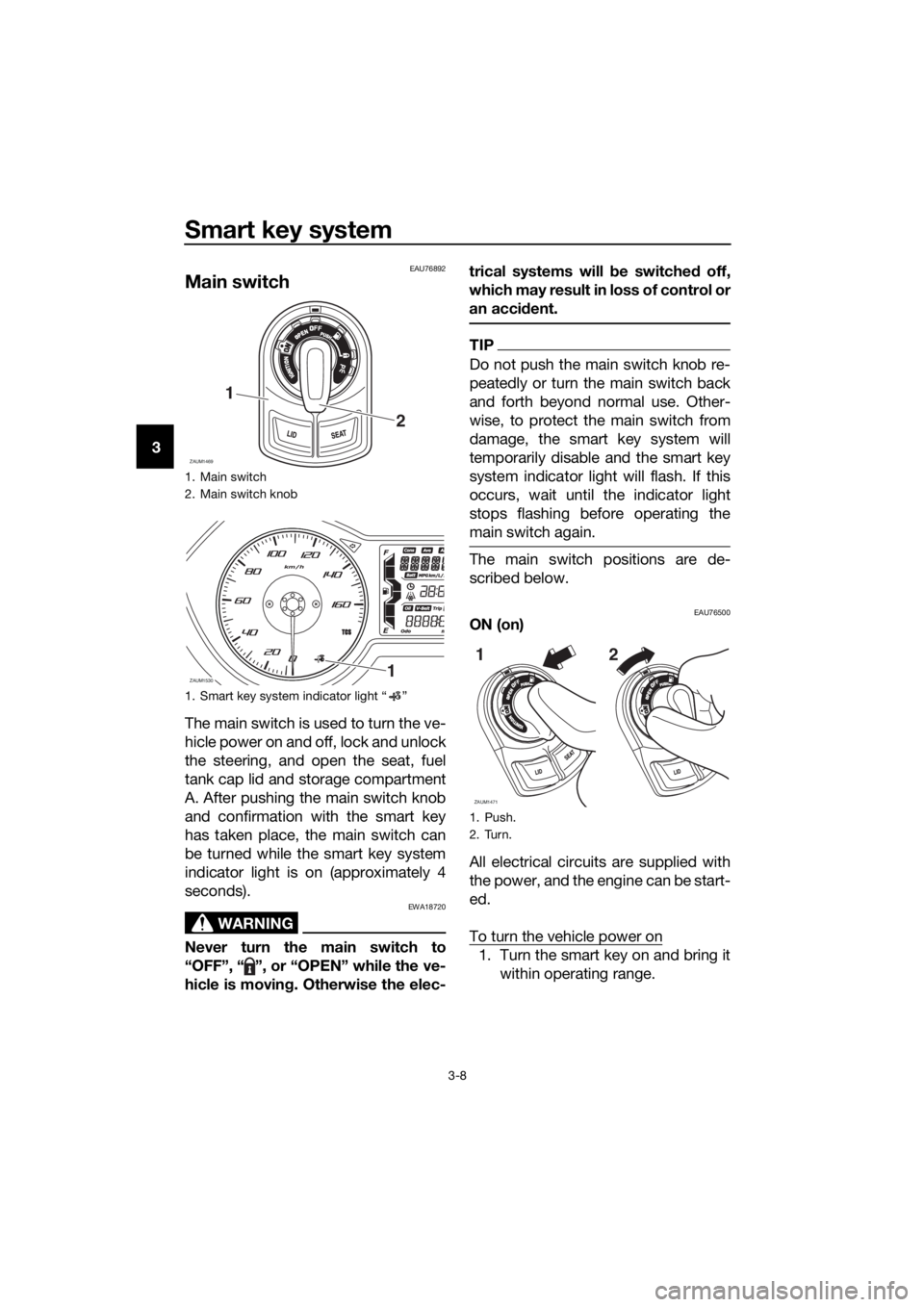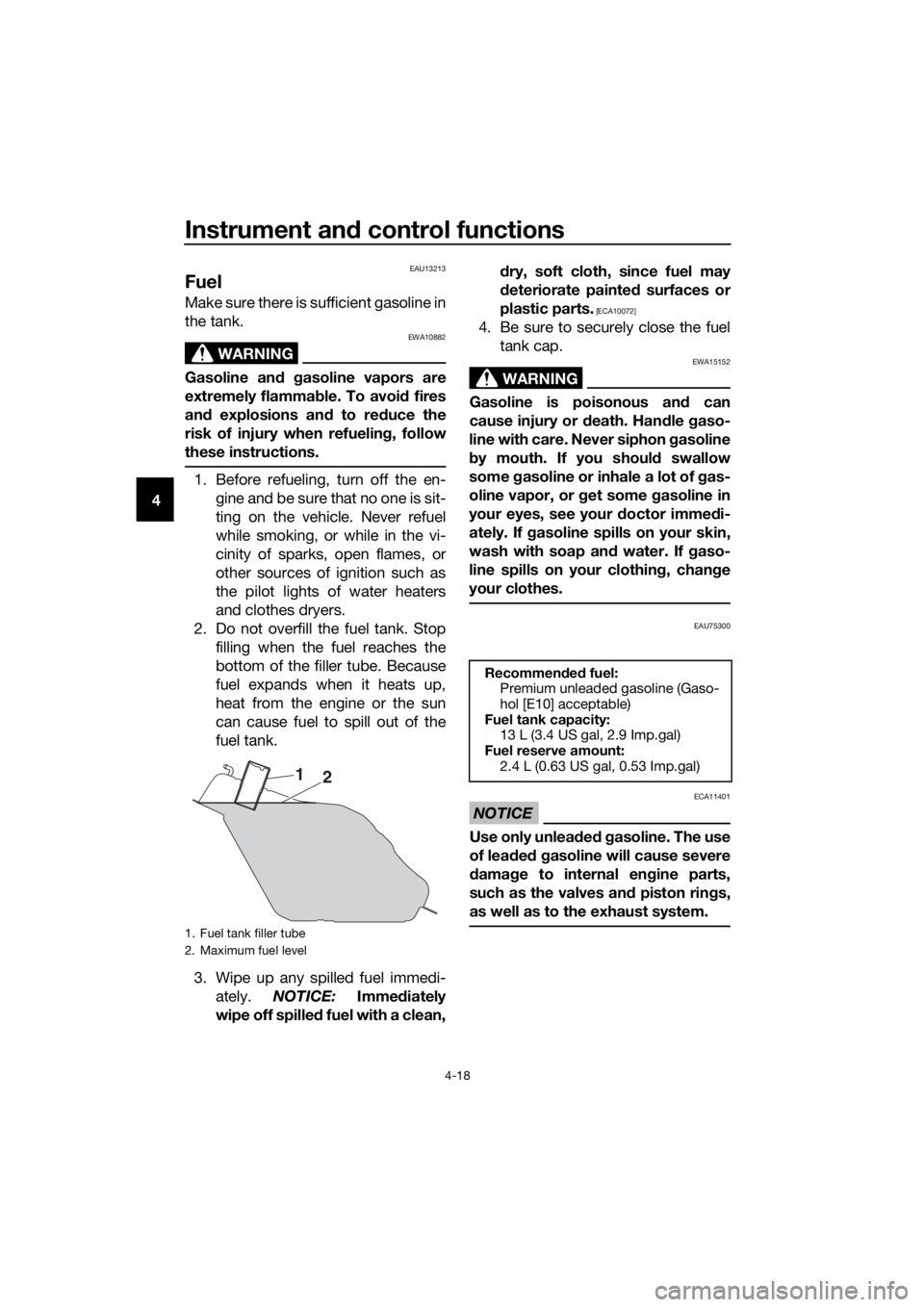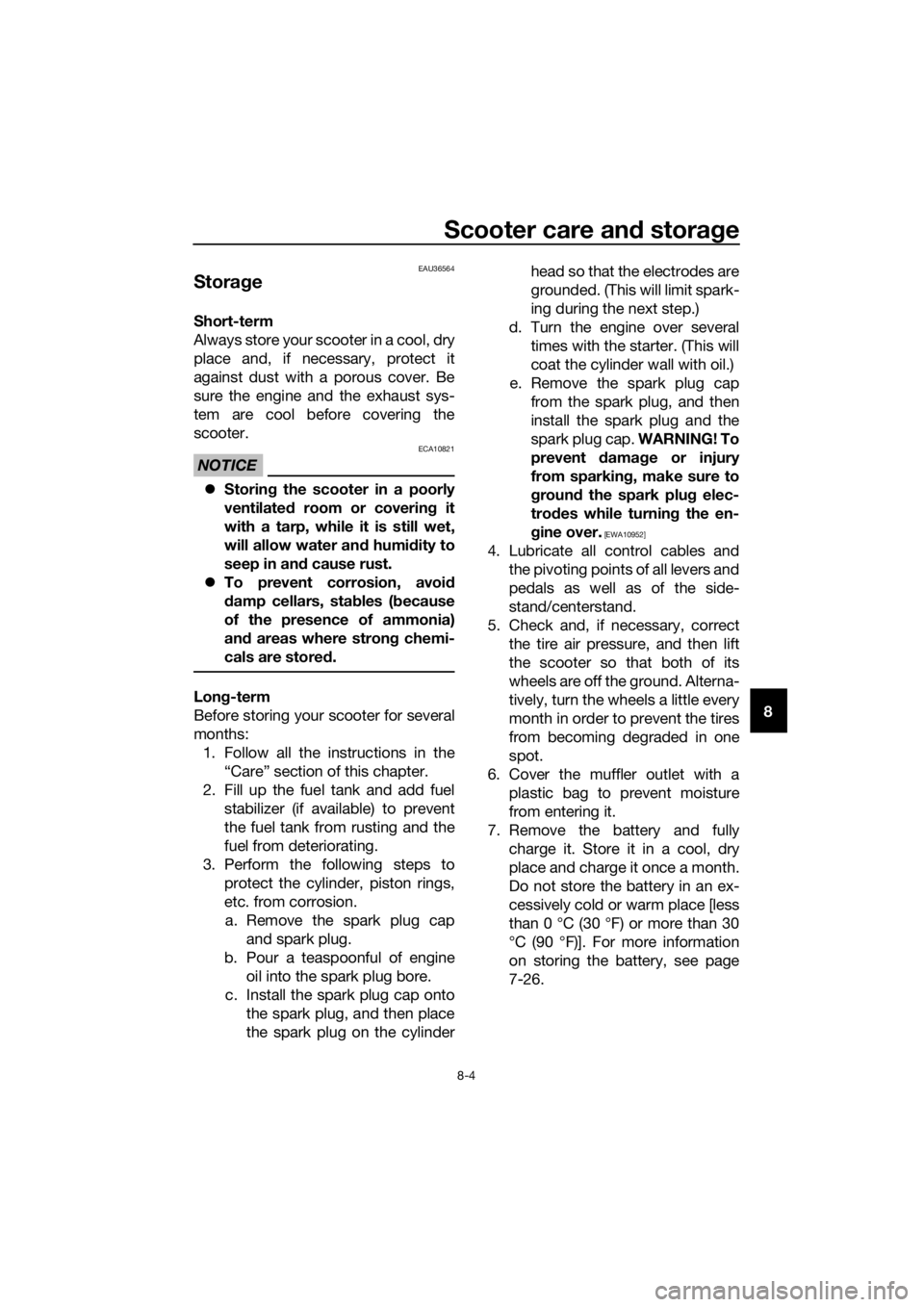fuel cap YAMAHA XMAX 125 2018 Owners Manual
[x] Cancel search | Manufacturer: YAMAHA, Model Year: 2018, Model line: XMAX 125, Model: YAMAHA XMAX 125 2018Pages: 114, PDF Size: 8.24 MB
Page 5 of 114

Table of contents
Safety information............................1-1
Further safe-riding points ................1-5
Description........................................2-1
Left view ..........................................2-1
Right view........................................2-2
Controls and instruments ................2-3
Smart key system ............................3-1
Smart key system............................3-1
Operating range of the smart key
system .........................................3-2
Handling of the smart key and
mechanical keys ..........................3-3
Smart key ........................................3-5
Replacing the smart key battery .....3-6
Main switch .....................................3-8
Instrument and control functions....4-1
Indicator lights and warning
lights ............................................4-1
Speedometer...................................4-2
Tachometer .....................................4-3
Multi-function display......................4-3
Handlebar switches.......................4-12
Front brake lever ...........................4-13
Rear brake lever ............................4-14
ABS ...............................................4-14
Traction control system.................4-15
Fuel tank cap.................................4-17
Fuel................................................4-18
Fuel tank overflow hose ................4-19
Catalytic converters .....................4-20
Storage compartments .................4-20
Windshield.....................................4-22
Handlebar position .......................4-25
Adjusting the shock absorber
assemblies .................................4-25
Sidestand ......................................4-26
Ignition circuit cut-off system........4-27
Auxiliary DC jack ..........................4-29For your safety – pre-operation
checks............................................... 5-1
Operation and important riding
points................................................. 6-1
Starting the engine.......................... 6-2
Starting off ...................................... 6-3
Acceleration and deceleration ........ 6-3
Braking............................................ 6-4
Tips for reducing fuel
consumption................................ 6-5
Engine break-in ............................... 6-5
Parking ............................................ 6-6
Periodic maintenance and
adjustment........................................ 7-1
Owner’s tool kit ............................... 7-2
Periodic maintenance chart for the
emission control system.............. 7-3
General maintenance and
lubrication chart........................... 7-4
Removing and installing the
panel ............................................ 7-7
Checking the spark plug ................. 7-8
Engine oil ........................................ 7-9
Final transmission oil .................... 7-11
Coolant ......................................... 7-12
Air filter and V-belt case air filter
elements and check hoses........ 7-14
Checking the throttle grip free
play ............................................ 7-15
Valve clearance ............................. 7-16
Tires .............................................. 7-16
Cast wheels .................................. 7-18
Checking the front and rear brake
lever free play ............................ 7-19
Checking the front and rear brake
pads........................................... 7-20
Checking the brake fluid level....... 7-20
Changing the brake fluid............... 7-21
Checking the V-belt ...................... 7-22
Checking and lubricating the
cables ........................................ 7-22
Checking and lubricating the
throttle grip and cable ............... 7-23
UBL2E0E0.book Page 1 Friday, June 23, 2017 9:30 AM
Page 13 of 114

Description
2-2
2
EAU63391
Right view
2345,61
87
1. Rear storage compartment (page 4-20)
2. Fuel tank cap (page 4-17)
3. Storage compartment B (page 4-20)
4. Windshield (page 4-22)
5. Battery (page 7-26)
6. Fuses (page 7-27)
7. Centerstand (page 7-24)
8. Shock absorber assembly spring preload adjusting ring (page 4-25)
UBL2E0E0.book Page 2 Friday, June 23, 2017 9:30 AM
Page 22 of 114

Smart key system
3-8
3
EAU76892
Main switch
The main switch is used to turn the ve-
hicle power on and off, lock and unlock
the steering, and open the seat, fuel
tank cap lid and storage compartment
A. After pushing the main switch knob
and confirmation with the smart key
has taken place, the main switch can
be turned while the smart key system
indicator light is on (approximately 4
seconds).
WARNING
EWA18720
Never turn the main switch to
“OFF”, “ ”, or “OPEN” while the ve-
hicle is moving. Otherwise the elec-trical systems will be switched off,
which may result in loss of control or
an accident.
TIP
Do not push the main switch knob re-
peatedly or turn the main switch back
and forth beyond normal use. Other-
wise, to protect the main switch from
damage, the smart key system will
temporarily disable and the smart key
system indicator light will flash. If this
occurs, wait until the indicator light
stops flashing before operating the
main switch again.
The main switch positions are de-
scribed below.
EAU76500ON (on)
All electrical circuits are supplied with
the power, and the engine can be start-
ed.
To turn the vehicle power on
1. Turn the smart key on and bring it
within operating range.
1. Main switch
2. Main switch knob
1. Smart key system indicator light “ ”
ZAUM1469
2
1
ZAUM15301
1. Push.
2. Turn.
ZAUM1471
1
2
UBL2E0E0.book Page 8 Friday, June 23, 2017 9:30 AM
Page 25 of 114

Smart key system
3-11
3 To lock the steering
1. Turn the handlebar all the way to
the left.
2. With the smart key turned on and
within operating range, push the
main switch knob.
3. While the smart key system indi-
cator light is on, push and turn the
main switch to “ ”.
TIP
If the steering will not lock, try turning
the handlebar back to the right slightly.
To unlock the steering
1. With the smart key turned on and
within operating range, push the
main switch knob.
2. While the smart key system indi-
cator light is on, push and turn the
main switch to the desired posi-
tion.
EAU76903 (parking)
The hazard lights and turn signal lights
can be turned on, but all other electri-
cal systems are off.To use the “ ” position
1. With the main switch in the “ ”
position and the smart key turned
on and within operating range,
push the main switch knob.
2. While the smart key system indi-
cator is light on, turn the main
switch to “ ”.
To exit the “ ” position
Simply turn the main switch to “ ”.
NOTICE
ECA20760
Using the hazard or turn signal lights
for an extended length of time may
cause the battery to discharge.
EAU79000“ ” (fuel tank cap lid)
To open the fuel tank cap lid
1. With the smart key turned on and
within operating range, push the
main switch knob.
2. While the smart key system indi-
cator light is on, turn the main
switch to “ ”.
To close the fuel tank cap lid
Push the fuel tank cap lid down until it
is closed.
1. Push.
2. Push and turn.
ZAUM1476
12
1. Push.
2. Turn.
ZAUM1477
1
2
UBL2E0E0.book Page 11 Friday, June 23, 2017 9:30 AM
Page 26 of 114

Smart key system
3-12
3
TIP
Make sure that fuel tank cap lid is se-
curely closed before starting off.
UBL2E0E0.book Page 12 Friday, June 23, 2017 9:30 AM
Page 43 of 114

Instrument and control functions
4-17
4
EAU78502
Fuel tank cap
To remove the fuel tank cap
1. Turn the main switch to “ ” to
open the fuel tank cap lid.
2. Turn the fuel tank cap counter-
clockwise until the release
mark “ ” aligns with “ ”, and
then pull the cap off.
To install the fuel tank cap
1. Insert the fuel tank cap onto the
tank opening and turn it clockwise
until the install mark “ ” aligns
with “ ”.2. Close the fuel tank cap lid.
WARNING
EWA11092
Make sure that the fuel tank cap is
properly closed after filling fuel.
Leaking fuel is a fire hazard.
1. Fuel tank cap lid
1. Fuel tank cap
2. Release mark “ ”
1
1
2
1. Install mark Ž
1
UBL2E0E0.book Page 17 Friday, June 23, 2017 9:30 AM
Page 44 of 114

Instrument and control functions
4-18
4
EAU13213
Fuel
Make sure there is sufficient gasoline in
the tank.
WARNING
EWA10882
Gasoline and gasoline vapors are
extremely flammable. To avoid fires
and explosions and to reduce the
risk of injury when refueling, follow
these instructions.
1. Before refueling, turn off the en-
gine and be sure that no one is sit-
ting on the vehicle. Never refuel
while smoking, or while in the vi-
cinity of sparks, open flames, or
other sources of ignition such as
the pilot lights of water heaters
and clothes dryers.
2. Do not overfill the fuel tank. Stop
filling when the fuel reaches the
bottom of the filler tube. Because
fuel expands when it heats up,
heat from the engine or the sun
can cause fuel to spill out of the
fuel tank.
3. Wipe up any spilled fuel immedi-
ately. NOTICE: Immediately
wipe off spilled fuel with a clean,dry, soft cloth, since fuel may
deteriorate painted surfaces or
plastic parts.
[ECA10072]
4. Be sure to securely close the fuel
tank cap.
WARNING
EWA15152
Gasoline is poisonous and can
cause injury or death. Handle gaso-
line with care. Never siphon gasoline
by mouth. If you should swallow
some gasoline or inhale a lot of gas-
oline vapor, or get some gasoline in
your eyes, see your doctor immedi-
ately. If gasoline spills on your skin,
wash with soap and water. If gaso-
line spills on your clothing, change
your clothes.
EAU75300
NOTICE
ECA11401
Use only unleaded gasoline. The use
of leaded gasoline will cause severe
damage to internal engine parts,
such as the valves and piston rings,
as well as to the exhaust system.
1. Fuel tank filler tube
2. Maximum fuel level
1
2
Recommended fuel:
Premium unleaded gasoline (Gaso-
hol [E10] acceptable)
Fuel tank capacity:
13 L (3.4 US gal, 2.9 Imp.gal)
Fuel reserve amount:
2.4 L (0.63 US gal, 0.53 Imp.gal)
UBL2E0E0.book Page 18 Friday, June 23, 2017 9:30 AM
Page 103 of 114

Scooter care and storage
8-4
8
EAU36564
Storage
Short-term
Always store your scooter in a cool, dry
place and, if necessary, protect it
against dust with a porous cover. Be
sure the engine and the exhaust sys-
tem are cool before covering the
scooter.
NOTICE
ECA10821
Storing the scooter in a poorly
ventilated room or covering it
with a tarp, while it is still wet,
will allow water and humidity to
seep in and cause rust.
To prevent corrosion, avoid
damp cellars, stables (because
of the presence of ammonia)
and areas where strong chemi-
cals are stored.
Long-term
Before storing your scooter for several
months:
1. Follow all the instructions in the
“Care” section of this chapter.
2. Fill up the fuel tank and add fuel
stabilizer (if available) to prevent
the fuel tank from rusting and the
fuel from deteriorating.
3. Perform the following steps to
protect the cylinder, piston rings,
etc. from corrosion.
a. Remove the spark plug cap
and spark plug.
b. Pour a teaspoonful of engine
oil into the spark plug bore.
c. Install the spark plug cap onto
the spark plug, and then place
the spark plug on the cylinderhead so that the electrodes are
grounded. (This will limit spark-
ing during the next step.)
d. Turn the engine over several
times with the starter. (This will
coat the cylinder wall with oil.)
e. Remove the spark plug cap
from the spark plug, and then
install the spark plug and the
spark plug cap. WARNING! To
prevent damage or injury
from sparking, make sure to
ground the spark plug elec-
trodes while turning the en-
gine over.
[EWA10952]
4. Lubricate all control cables and
the pivoting points of all levers and
pedals as well as of the side-
stand/centerstand.
5. Check and, if necessary, correct
the tire air pressure, and then lift
the scooter so that both of its
wheels are off the ground. Alterna-
tively, turn the wheels a little every
month in order to prevent the tires
from becoming degraded in one
spot.
6. Cover the muffler outlet with a
plastic bag to prevent moisture
from entering it.
7. Remove the battery and fully
charge it. Store it in a cool, dry
place and charge it once a month.
Do not store the battery in an ex-
cessively cold or warm place [less
than 0 °C (30 °F) or more than 30
°C (90 °F)]. For more information
on storing the battery, see page
7-26.
UBL2E0E0.book Page 4 Friday, June 23, 2017 9:30 AM
Page 105 of 114

Specifications
9-1
9
Dimensions:
Overall length:
2185 mm (86.0 in)
Overall width:
775 mm (30.5 in)
Overall height:
1415/1465 mm (55.7/57.7 in)
Seat height:
795 mm (31.3 in)
Wheelbase:
1526 mm (60.1 in)
Ground clearance:
130 mm (5.12 in)
Minimum turning radius:
2.5 m (8.20 ft)
Weight:
Curb weight:
175 kg (386 lb)
Engine:
Combustion cycle:
4-stroke
Cooling system:
Liquid cooled
Valve train:
SOHC
Number of cylinders:
Single cylinder
Displacement:
124 cm³
Bore × stroke:
52.0 × 58.6 mm (2.05 × 2.31 in)
Compression ratio:
11.2 : 1
Starting system:
Electric starter
Lubrication system:
Wet sump
Engine oil:
Recommended brand:
YAMALUBE
SAE viscosity grades:
10W-40
Recommended engine oil grade:
API service SG type or higher, JASO
standard MA
Engine oil quantity:
Without oil filter element replacement:
1.40 L (1.48 US qt, 1.23 Imp.qt)
With oil filter removal:
1.50 L (1.59 US qt, 1.32 Imp.qt)
Final transmission oil:
Type:
YAMALUBE 10W-40 or SAE 10W-30 type
SE motor oil
Quantity:
0.21 L (0.22 US qt, 0.18 Imp.qt)
Coolant quantity:
Coolant reservoir (up to the maximum level
mark):
0.18 L (0.19 US qt, 0.16 Imp.qt)
Radiator (including all routes):
0.85 L (0.90 US qt, 0.75 Imp.qt)
Air filter:
Air filter element:
Oil-coated paper element
Fuel:
Recommended fuel:
Premium unleaded gasoline (Gasohol [E10]
acceptable)
Fuel tank capacity:
13 L (3.4 US gal, 2.9 Imp.gal)
Fuel reserve amount:
2.4 L (0.63 US gal, 0.53 Imp.gal)
Fuel injection:
Throttle body:
ID mark:
2DS1 01
Spark plug(s):
Manufacturer/model:
NGK/CR9E
Spark plug gap:
0.7–0.8 mm (0.028–0.031 in)
Clutch:
Clutch type:
Dry, centrifugal, shoe
Drivetrain:
Primary reduction ratio:
1.000
Final drive:
Gear
Secondary reduction ratio:
9.912 (41/14 x 44/13)
Transmission type:
V-belt automatic
Operation:
Centrifugal automatic type
Chassis:
Frame type:
Underbone
UBL2E0E0.book Page 1 Friday, June 23, 2017 9:30 AM
Page 110 of 114

11-1
11
Index
A
ABS ....................................................... 4-14
ABS warning light ................................... 4-1
Acceleration and deceleration ................ 6-3
Air filter and V-belt case air filter
elements ............................................. 7-14
Auxiliary DC jack ................................... 4-29
Auxiliary lights ....................................... 7-29
B
Battery .................................................. 7-26
Brake fluid, changing ............................ 7-21
Brake fluid level, checking .................... 7-20
Brake lever, front .................................. 4-13
Brake lever, rear.................................... 4-14
Brake levers, lubricating ....................... 7-23
Brake/tail light ....................................... 7-30
Braking.................................................... 6-4
C
Cables, checking and lubricating ......... 7-22
Care ........................................................ 8-1
Catalytic converters .............................. 4-20
Centerstand and sidestand, checking
and lubricating .................................... 7-24
Coolant ................................................. 7-12
D
Data recording, vehicle ......................... 10-2
Diagnostic connectors .......................... 10-2
Dimmer/Pass switch ............................. 4-12
E
Emergency mode.................................. 7-35
Engine break-in....................................... 6-5
Engine oil ................................................ 7-9
Engine serial number ............................ 10-1
Engine trouble warning light ................... 4-1
F
Final transmission oil ............................ 7-11
Front and rear brake lever free play,
checking ............................................. 7-19
Front and rear brake pads, checking.... 7-20
Front fork, checking .............................. 7-24
Front turn signal light ............................ 7-30
Fuel ....................................................... 4-18
Fuel consumption, tips for reducing ....... 6-5
Fuel tank cap ........................................ 4-17
Fuel tank overflow hose ........................ 4-19
Fuses, replacing.................................... 7-27
H
Handlebar position, adjusting ............... 4-25
Handlebar switches .............................. 4-12
Hazard switch ....................................... 4-12Headlights ............................................ 7-29
High beam indicator light ....................... 4-1
Horn switch .......................................... 4-12
I
Identification numbers .......................... 10-1
Ignition circuit cut-off system............... 4-27
Indicator lights and warning lights ......... 4-1
K
Key, handling of smart and mechanical
keys ...................................................... 3-3
L
License plate light bulb, replacing........ 7-31
M
Main switch ............................................ 3-8
Maintenance and lubrication, periodic ... 7-4
Maintenance, emission control
system.................................................. 7-3
Matte color, caution ............................... 8-1
Model label ........................................... 10-1
Multi-function display ............................. 4-3
O
Operating range of the smart key
system.................................................. 3-2
P
Panel, removing and installing ............... 7-7
Parking ................................................... 6-6
Part locations ......................................... 2-1
S
Safe-riding points ................................... 1-5
Safety information .................................. 1-1
Shock absorber assemblies,
adjusting............................................. 4-25
Sidestand ............................................. 4-26
Smart key ............................................... 3-5
Smart key battery, replacing .................. 3-6
Smart key system ................................... 3-1
Smart key system indicator light ............ 4-2
Smart key system, troubleshooting...... 7-32
Spark plug, checking ............................. 7-8
Specifications ......................................... 9-1
Speedometer .......................................... 4-2
Starting off.............................................. 6-3
Starting the engine ................................. 6-2
Steering, checking................................ 7-25
Stop/Run/Start switch .......................... 4-12
Storage ................................................... 8-4
Storage compartments ........................ 4-20
T
Tachometer ............................................ 4-3
UBL2E0E0.book Page 1 Friday, June 23, 2017 9:30 AM